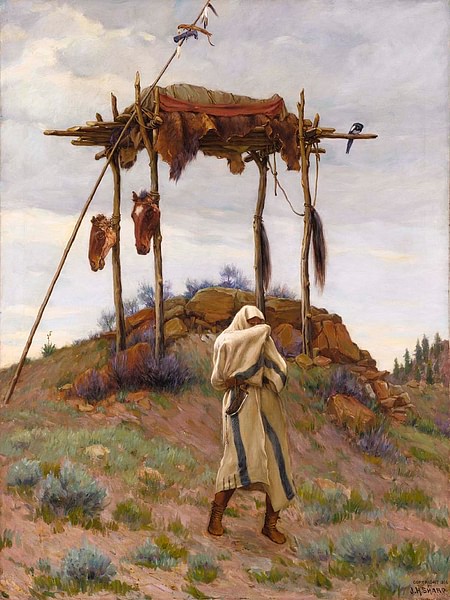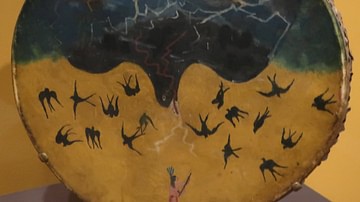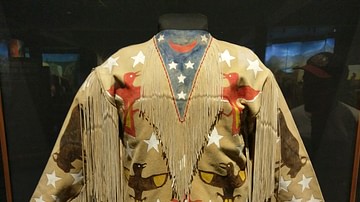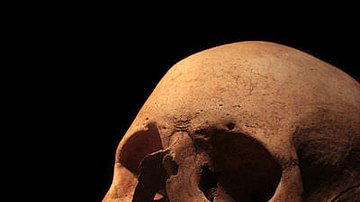The Man Who Wrestled with a Ghost (also given as The Indian Who Wrestled with a Ghost) is a Teton Sioux tale on how one should interact with the spirits of the dead in circumstances where one cannot avoid them. It is one of the best-known Native American ghost stories and among the most often anthologized.
Every Native American nation has its own ghost stories as ghosts are understood as a naturally occurring phenomenon like anything else in life. At the same time, however, people were warned against interaction with ghosts for several reasons. The spirit of the deceased might try to lure one to the land of the dead (as in the Pawnee story The Ghost Wife) or lure one away from one's family and community until one becomes a ghost (as in A Teton Ghost Story) and might also cause physical or psychological damage to a person.
The primary reason for avoiding ghosts, however, was that they were no longer the person one had known while they lived but now possessed supernatural knowledge – knowing the answer to the question of what happens after the death of the body. This information is denied to the living unless a glimpse is given to a person during a vision for a specific reason, and so interacting with a ghost would be dangerous in that the spirit might unwittingly or purposefully reveal some aspect of the afterlife, which was supposed to remain a secret.
Another danger to be avoided, owing to the nature of ghosts, was knowing one's future without permission from the Spirit World. Just as ghosts were understood to know all the secrets of the afterlife, so they were also believed to know the future. If one prayed for a vision and engaged in the proper rituals and self-sacrifice required, one might be granted insight into one's future by the Great Mystery and this would be in accordance with the divine plan for one's life.
If one received such information from a ghost freely, however, one would essentially be cheating in accepting a gift one had done nothing to deserve and to which one was not entitled. One would need to have given something, especially some good or service, even one would prefer not to, constituting a fair trade, to be worthy of receiving any words of direction or prophecy from the spirit world.
Sometimes, however, one had no choice in this matter of ghostly interaction when a spirit would suddenly appear. The Man Who Wrestled with a Ghost deals with two such circumstances and provides an audience with a kind of how-to instruction on the best ways of handling such situations.
Although, as in many other world civilizations, a ghost was thought to return due to improper funerary rites or a failure on the part of the living to observe their last wishes, in Native American belief, generally, ghosts could appear for any reason at all, and so one should be prepared in advance to deal with them as safely as possible, and as with all living things, one's best course was to treat them with respect.
Funerary Rites & Ghosts
Even though ghosts had their own reasons for returning from the land of the dead, one could be sure of a haunting if the proper funerary rites were not observed. The specific details of these rites varied from nation to nation, but however they were understood, they needed to be properly performed with the utmost respect and with an eye toward preventing the deceased from returning as a ghost, as scholar Larry J. Zimmerman observes:
It was widely believed that the dead were drawn back to where they had resided when alive. The Mohave and Yuma peoples burned down the house of the deceased in order to prevent his or her ghost from trying to return there. The Navajo simply abandoned the dwelling. In a similar vein, all the deceased's possessions might be given away to non-relatives, or even destroyed.
A corpse might be cremated, buried, or left to decompose in the open air on a scaffold or in trees. The resulting bones might be left on the ground or later gathered for interment in a conical or linear burial mound. Both scaffolds and burial mounds were sacred areas deemed by some to be spiritually dangerous. Among the Lakota, wanagi ("things of the shadow") spirits are said to guard the graves and can harm anyone who disturbs the dead…Because the dead often suffered anguish at being separated from the living, the living endeavored to ease their pain. The rituals accompanying death may be as simple as taboos in which the name of the dead cannot be uttered or may involve demonstrating how much a person was missed by enacting public displays of grief.
Among many Plains Indians groups, mourners cut their hair and wear it short for a year, slash their arms or chest, cut off a fingertip, or wear mourning clothes. Many grieved for a period and others carried out simple, gentle ceremonies, such as offering food to ease the dead person's passage into the afterworld. In some tribes, people make lengthy speeches to the spirit of the deceased and request that he or she stays away from the living. (247-248)
Even if all these rites were observed properly, however, a ghost might still return – not necessarily to haunt the living but simply to visit the places it had known in life. Further, as Zimmerman notes, a ghost might haunt only the area around their grave and would not trouble the living unless someone disturbed their peace.

In The Man Who Wrestled with a Ghost, the two spirits the young warrior encounters represent these two types of spirits. The first is the ghost of a woman whose burial scaffold is next to the spot where the warrior made camp in the night, while the second is of a man who seems to be doing the same things he did while he lived.
Text
The following text is taken from Native American Myths & Legends, edited by J. K. Jackson.
A young man went alone on the warpath. At length he reached a wood. One day, as he was going along, he heard a voice. He said, "I shall have company." As he was approaching a forest, he heard someone halloo. Behold, it was an owl.
By and by he drew near another wood, and as night was coming on, he lay down to rest. At the edge of the trees, he lay down in the open air. At midnight he was aroused by the voice of a woman. She was wailing, "My son! my son!" Still, he remained where he was, and put more wood on the fire. He lay with his back to the fire. He tore a hole in his blanket large enough to peep through.
Soon he heard twigs break under the feet of one approaching, so he looked through his blanket without rising. Behold, a woman of the olden days was coming. She wore a skin dress with long fringe. A buffalo robe was fastened around her at the waist. Her necklace was of very large beads, and her leggings were covered with beads or porcupine work. Her robe was drawn over her head and she was snuffing as she came.
The man lay with his legs stretched out, and she stood by him. She took him by one foot, which she raised very slowly. When she let it go, it fell with a thud as though he were dead. She raised it a second time; then a third time. Still the man did not move. Then the woman pulled a very rusty knife from the front of her belt, seized his foot suddenly and was about to lift it and cut it, when up sprang the man.
He said, "What are you doing?" Then he shot at her suddenly. She ran into the forest screaming, "Yun! yun! yun! yun! yun! yun!" She plunged into the forest and was seen no more.
Again the man covered his head with his blanket, but he did not sleep. When day came, he raised his eyes. Behold, there was a burial scaffold, with the blankets all ragged and dangling. He thought, "Was this the ghost that came to me?"
Again he came to a wood where he had to remain for the night. He started a fire. As he sat there, suddenly he heard someone singing. He made the woods ring. The man shouted to the singer, but no answer was paid. The man had a small quantity of wasna, which was grease mixed with pounded buffalo meat, and wild cherry; he also had plenty of tobacco.
So when the singer came and asked him for food, the man said, "I have nothing."
The ghost said, "Not so; I know you have some wasna."
Then the man gave some of it to the ghost and filled his pipe. After the meal, when the stranger took the pipe and held it by the stem, the traveler saw that it was nothing but bones. There was no flesh. Then the stranger's robe dropped back from his shoulders. Behold, all his ribs were visible. There was no flesh on them. The ghost did not open his lips when he smoked. The smoke came pouring out through his ribs.
When he had finished smoking, the ghost said, "Ho! we must wrestle together. If you can throw me, you shall kill the enemy without hindrance and steal some horses."
The young man agreed. But first he threw an armful of brush on the fire. He put plenty of brush near the fire.
Then the ghost rushed at the man. He seized him with his bony hands, which was very painful; but this mattered not. The man tried to push off the ghost, whose legs were very powerful. When the ghost was pulled near the fire, he became weak; but when he pulled the young man toward the darkness, he became strong. As the fire got low, the strength of the ghost increased.
Just as the man began to get weary, the day broke. Then the struggle began again. As they drew near the fire again, the man made a last effort; with his foot he pushed more brush into the fire. The fire blazed up again suddenly. Then the ghost fell, just as if he was coming to pieces.
So the man won in wrestling. Also, he killed his enemy and stole some horses. It came out just as the ghost said. That is why people believe what ghosts say.
Commentary
The story is carefully crafted from the beginning with the appearance of the owl. Scholar Bobby Lake-Thom notes:
The owl is considered a bad sign and a bad power by most Native American tribal groups. It is a messenger of evil, sickness, or of a fatal accident. It is also considered a sign of death. (116)
In this story, the disembodied voice the warrior hears signaling that he will have company, followed by the appearance of the owl, would have alerted the original audience to the theme of the story and how they would be hearing about death, the afterlife, ghosts, or all three. The events of the story unfold to finally arrive at the conclusion that people believe what ghosts say because ghosts know better than mortals and so should be respected, just like the owl whose knowledge is also superior to that of humans.
The warrior makes camp in the dark of the night and so is unaware he has set himself up below the burial scaffold of the woman whose ghost he will soon meet. When the ghost appears, she is wailing for her son, but it is left unclear whether she thinks the warrior is her son visiting her grave or is grieving for a son she has lost sometime before. If the second, it signals this is a ghost trapped on the earthly plane by attachment to the past – she cannot move on because she cannot let go – while, if the first, it might explain why she decides to cut off his foot as a trophy; because, when she sees he is not her son and is trespassing on her gravesite – even though he appears to be dead - she feels the need to take something from him in payment.
With the first ghost, the warrior makes two mistakes. The first, of course, is camping near her grave, and the second is not treating the spirit with respect by pretending to be dead, offering her nothing by way of hospitality as her guest, and then finally shooting at her. Although the ghost might be a wanagi spirit guarding a grave, she seems more to be someone trapped by their attachment to the past, who might have been comforted and left the warrior in peace if she had been offered some token.
His interaction with the second ghost differs significantly in that, although he at first lies to the spirit about not having any food, he then observes all the rites of hospitality in offering the singing ghost the gifts of wasna and tobacco. When the ghost demands that they wrestle, the young warrior agrees, just as he would with a living guest, but, in quickly arranging the brush in and around the fire, assures himself of at least some chance of coming out the winner – a precaution he would not have taken against a living opponent, as that would be considered cheating.
In this interaction, a deal is made through the exchange of goods and services. The young warrior gives the spirit food and tobacco and engages in the match demanded; the ghost gives him the prophecy of success. In the end, the young warrior is successful in his mission of defeating his enemy and stealing horses, and it is left to the audience to decide whether this outcome would have been the same if he had not met the ghost or if he had not engaged with him respectfully.
Conclusion
It is possible, of course, that the young warrior would have been successful even if he had not met the ghost. There is nothing in the story to suggest that the young warrior has told the ghost about his mission and yet the ghost tells him how, if he wins the match, he will kill his enemy easily and steal the horses – suggesting foreknowledge of the event. This outcome is prophesied, however, only if the warrior agrees to wrestle the ghost. Having once engaged with the spirit, then, it is the warrior's choices at that time that decide whether he will succeed later.
In Native American belief, the time of one's death might be appointed but how one lived one's life prior to that moment was a matter of free will and personal choice. The Man Who Wrestled with a Ghost highlights the importance of one's choices through the young warrior's interaction with the spirits and, finally, that choice comes down to either denying or showing respect for others.
Just as the deceased required respectful rites to be followed in the funerary observances, so should their ghosts be met with the same recognition. One was encouraged to avoid ghosts for one's own safety but, having once engaged, it was in one's best interest to honor the ghost with whatever one had to offer, just as one was expected to do for any of the living and for loved ones who, one day, might appear as ghosts themselves to someone else.







